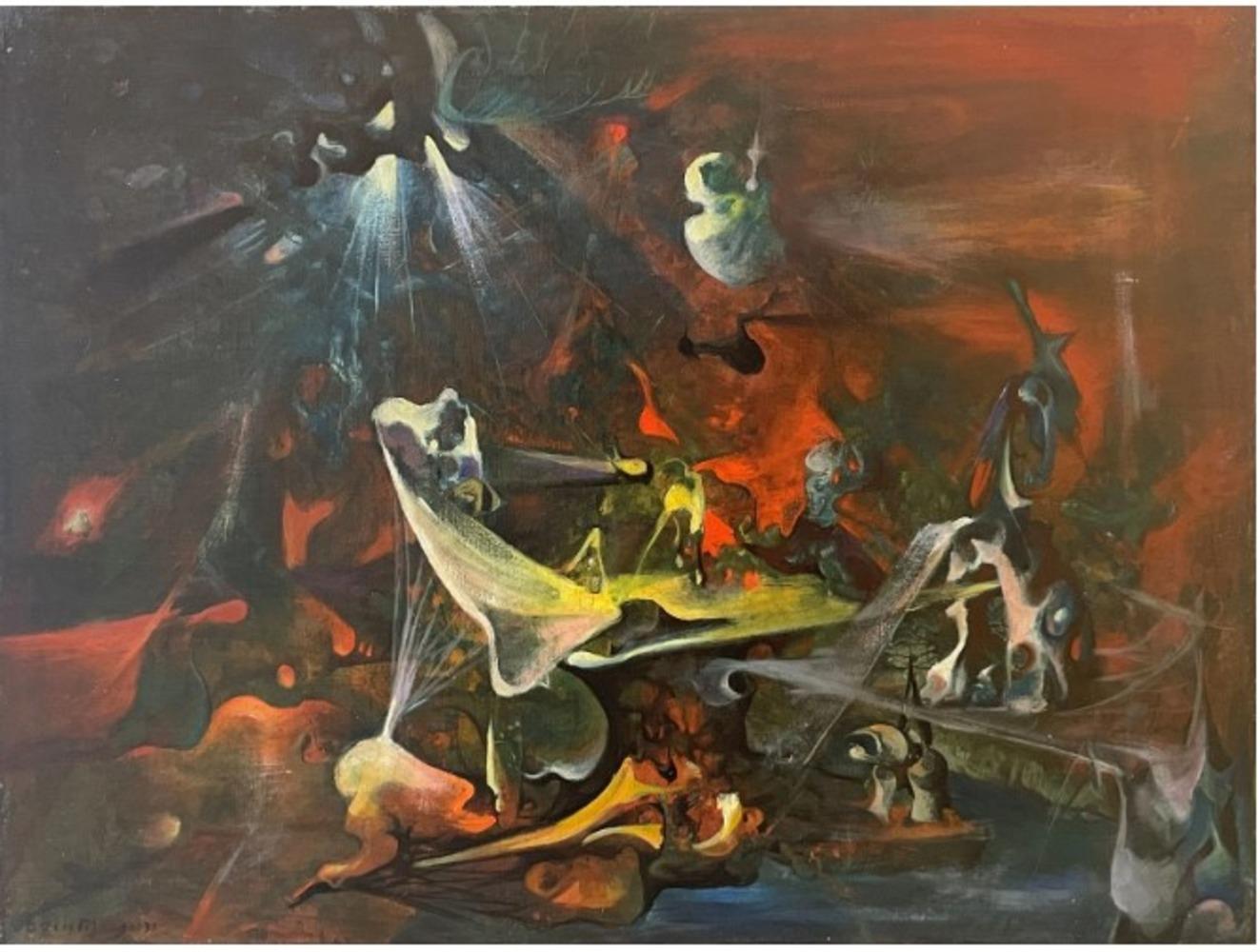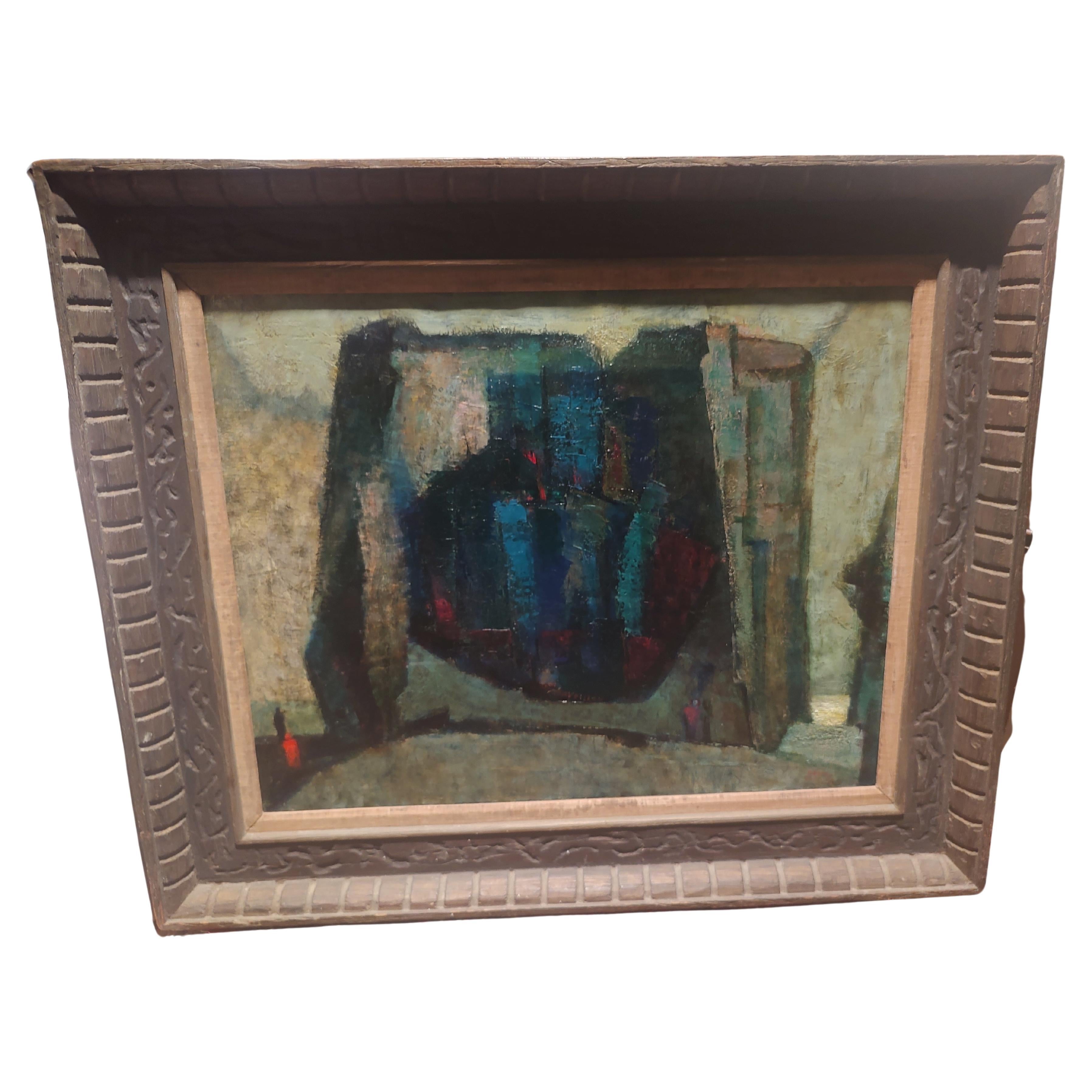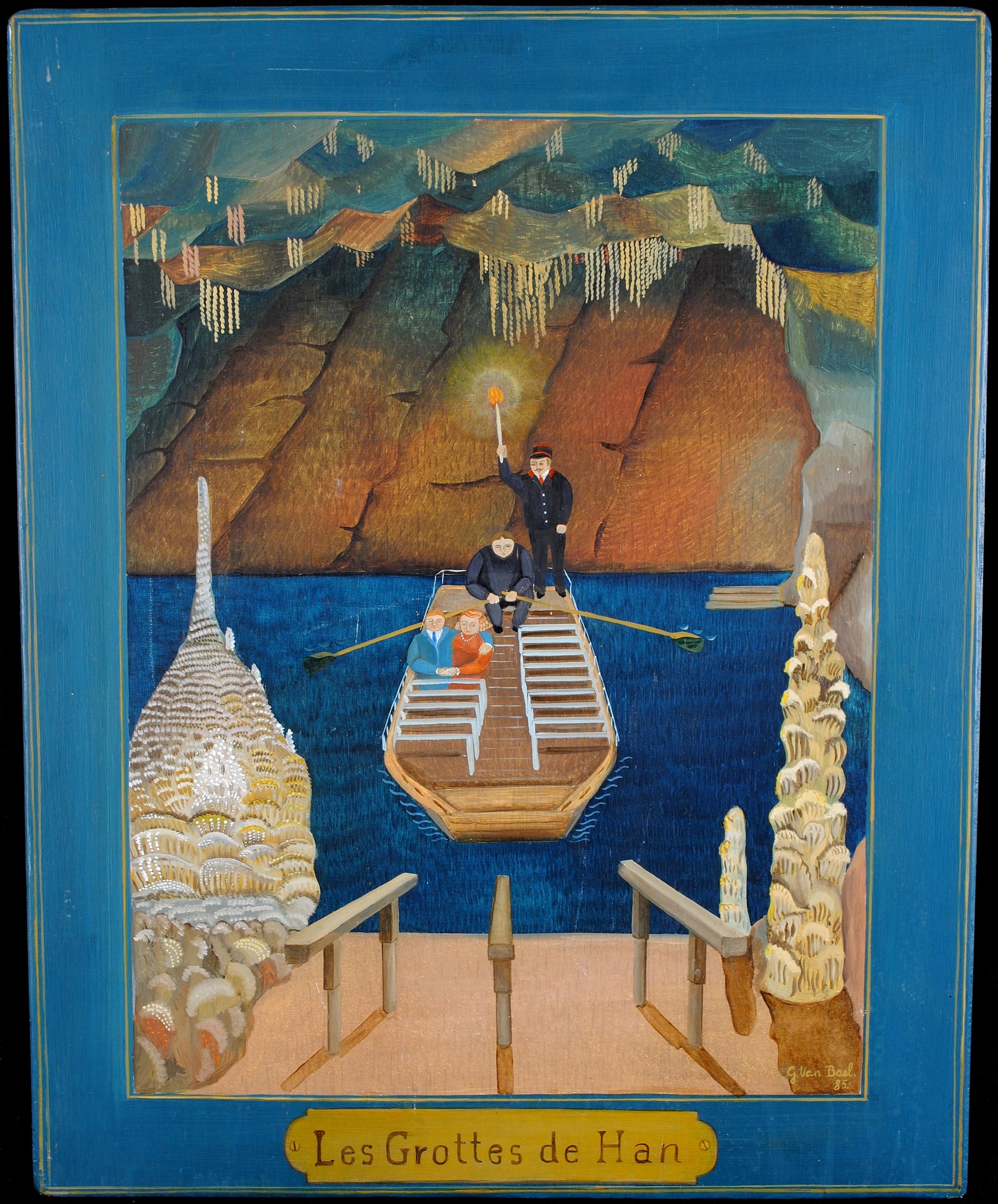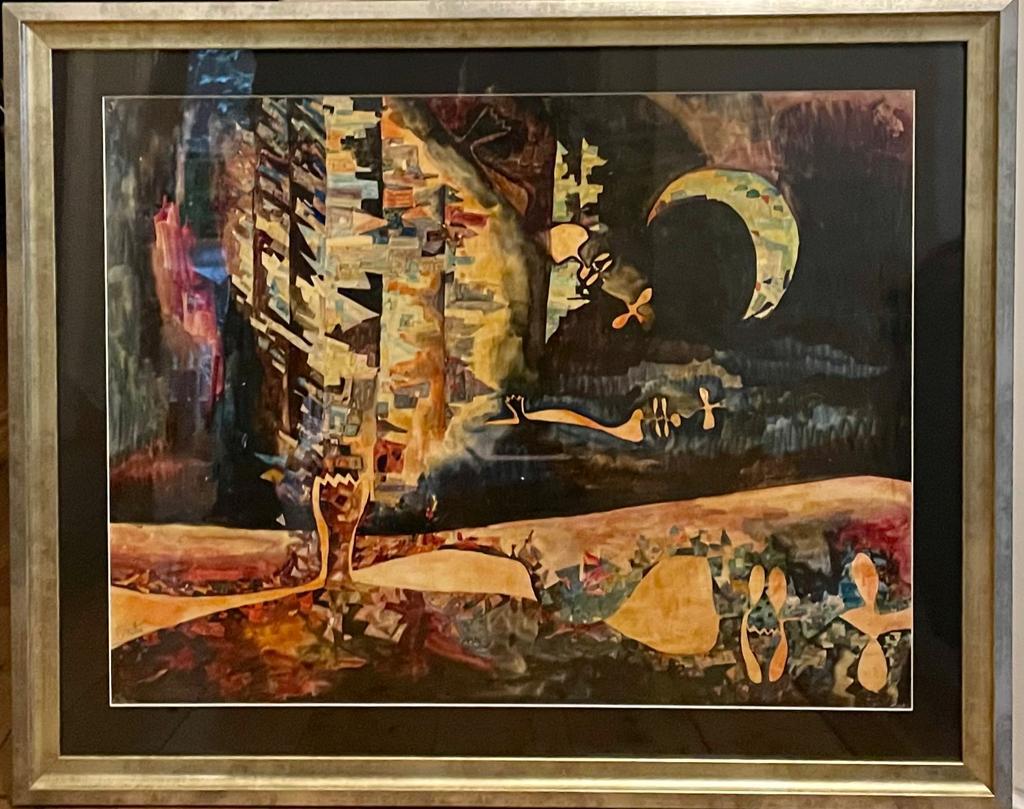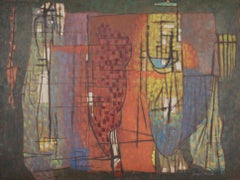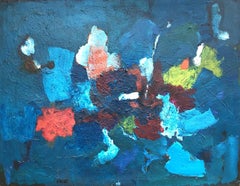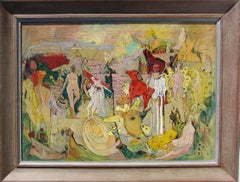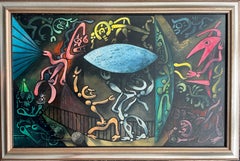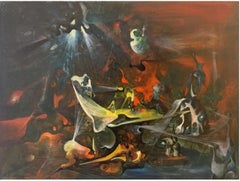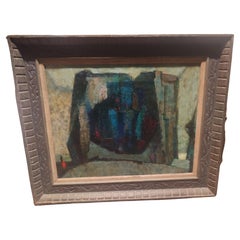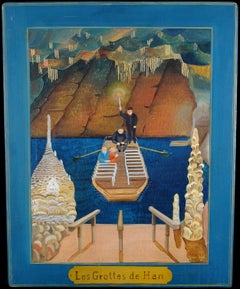Items Similar to The Cavern 1950 painting by John Atherton
Want more images or videos?
Request additional images or videos from the seller
1 of 8
John AthertonThe Cavern 1950 painting by John Atherton1950
1950
$26,500
£20,182.63
€23,263.42
CA$37,073.32
A$41,667.96
CHF 21,699.58
MX$506,785.47
NOK 277,672.65
SEK 263,315.50
DKK 173,622.88
Shipping
Retrieving quote...The 1stDibs Promise:
Authenticity Guarantee,
Money-Back Guarantee,
24-Hour Cancellation
About the Item
Signed lower right: "Atherton", inscribed "John Atherton Original Tempera 7/28/50" on verso.
Artwork measures 16" x 20" and framed 20" x 24" x 2 ½"
About this artists: John Atherton (1900-1952) did not show an early aptitude for art; rather, his first love was nature and the activities he relished there, mainly fishing and hunting. Born in Brainerd, Minnesota in 1900, he learned to fish with his father from the age of four. Later the family moved to Spokane, Washington, and when he was old enough, Atherton worked at a variety of jobs to help support his family. One such job, in the sorting plant of a lead and silver mine, paid $4.25 a day—a good wage, though he never had time to spend his money, since he worked seven days a week.
After serving in the Navy for a year during World War I, Atherton was determined to get an education. He worked as a sign painter and played the banjo in a dance band, finally accumulating enough money to enroll in the California School of Fine Arts in San Francisco. Once there, he worked like a fiend, attending classes both during the day and at night, getting the best training available.
Though he had always intended to be a fine artist, Atherton’s first jobs were for commercial art firms. In 1929, using the prize money won for a painting he entered in an art competition, Atherton and his wife moved to New York City. Though the economic situation was difficult in those years, he managed to keep going by taking commissions for magazine illustrations, and over the years he would paint more than forty covers for The Saturday Evening Post.
In 1938, an artist friend suggested that he use the same flat, decorative style as his commercial work for his gallery paintings. This was a breakthrough for Atherton; soon afterwards he held a one-man show at the Julien Levy Gallery in New York, and his paintings began to be collected by museums including the Museum of Modern Art in New York and the Metropolitan Museum of Art.
Atherton’s reputation increased to a national scale when he designed the art deco stone lithograph poster for the 1939 World’s Fair that strikingly depicted Earth and its atmospheric layers in the lap of Liberty.
Atherton was highly influenced by the magic realist movement that had roots in European surrealism but carried distinctly American undertones. While other magic realists focused on themes of agriculture and fertility, The artist often opted for more industrial landscapes. He said in his statement for the seminal 1943 Museum of Modern Art exhibition, American Realists and Magic Realists. He noted, “Any painting lives or will last because it is well painted, regardless of whether it is a potato or a human body. By this I do not mean mere technical dexterity but painting which builds the spirit of the forms.”
- Creator:John Atherton (1899 - 1972, American)
- Creation Year:1950
- Dimensions:Height: 16 in (40.64 cm)Width: 20 in (50.8 cm)
- Medium:
- Movement & Style:
- Period:
- Condition:
- Gallery Location:Hudson, NY
- Reference Number:Seller: AtJo0021stDibs: LU2465212925012
About the Seller
5.0
Vetted Professional Seller
Every seller passes strict standards for authenticity and reliability
Established in 1973
1stDibs seller since 2023
12 sales on 1stDibs
Typical response time: 2 hours
- ShippingRetrieving quote...Shipping from: Hudson, NY
- Return Policy
Authenticity Guarantee
In the unlikely event there’s an issue with an item’s authenticity, contact us within 1 year for a full refund. DetailsMoney-Back Guarantee
If your item is not as described, is damaged in transit, or does not arrive, contact us within 7 days for a full refund. Details24-Hour Cancellation
You have a 24-hour grace period in which to reconsider your purchase, with no questions asked.Vetted Professional Sellers
Our world-class sellers must adhere to strict standards for service and quality, maintaining the integrity of our listings.Price-Match Guarantee
If you find that a seller listed the same item for a lower price elsewhere, we’ll match it.Trusted Global Delivery
Our best-in-class carrier network provides specialized shipping options worldwide, including custom delivery.More From This Seller
View AllTransition oil painting by Joseph Meert
By Joseph Meert
Located in Hudson, NY
Artist Joseph Meert studied at the Kansas City Art Institute and later the Art Students League of New York after immigrating to the United States as a ...
Category
Mid-20th Century Abstract Abstract Paintings
Materials
Canvas, Oil
Deep as the Night, an oil painting by John Von Wicht
By John von Wicht
Located in Hudson, NY
This work is one of a group of over 100 works personally selected by the artist, and gifted to a close personal friend in 1969.
Exhibited: 1967 National Academy Annual Exhibition -...
Category
1960s Abstract Expressionist Abstract Paintings
Materials
Canvas, Oil
Ancient Revel oil painting by Wesley Lea
By Wesley Lea
Located in Hudson, NY
Signed and titled verso on stretcher "Lea Ancient Revel". Subtitled verso on label in artist's hand: "An attempt to marry ancient mineral matter with people".
Exhibited at the 194...
Category
1940s Abstract Figurative Paintings
Materials
Canvas, Oil
Inevitable Day – Birth of the Atom oil and tempera painting by Julio De Diego
By Julio de Diego
Located in Hudson, NY
Julio De Diego’s Atomic Series paintings made an extraordinary statement regarding the shock and fear that accompanied the dawn of the nuclear age. In the artist’s own words, “Scientists were working secretly to develop formidable powers taken from the mysterious depths of the earth - with the power to make the earth useless! Then, the EXPLOSION! . . . we entered the Atomic Age, and from there the neo-Atomic war begins. Explosions fell everywhere and man kept on fighting, discovering he could fight without flesh.”
To execute these works, De Diego developed a technique of using tempera underpainting before applying layer upon layer of pigmented oil glazes. The result is paintings with surfaces which were described as “bonelike” in quality. The forms seem to float freely, creating a three-dimensional visual effect. In the 1954 book The Modern Renaissance in American Art, author Ralph Pearson summarizes the series as “a fantastic interpretation of a weighty theme. Perhaps it is well to let fantasy and irony appear to lighten the devastating impact. By inverse action, they may in fact increase its weight.”
Bibliography
Art in America, April 1951, p.78
About this artists: Julio De Diego crafted a formidable persona within the artistic developments and political struggles of his time. The artist characterized his own work as “lyrical,” explaining, “through the years, the surrealists, the social-conscious painters and the others tried to adopt me, but I went my own way, good, bad or indifferent.” [1] His independence manifested early in life when de Diego left his parent’s home in Madrid, Spain, in adolescence following his father’s attempts to curtail his artistic aspirations. At the age of fifteen he held his first exhibition, set up within a gambling casino. He managed to acquire an apprenticeship in a studio producing scenery for Madrid’s operas, but moved from behind the curtains to the stage, trying his hand at acting and performing as an extra in the Ballet Russes’ Petrouchka with Nijinsky. He spent several years in the Spanish army, including a six-month stretch in the Rif War of 1920 in Northern Africa. His artistic career pushed ahead as he set off for Paris and became familiar with modernism’s forays into abstraction, surrealism, and cubism.
The artist arrived in the U.S. in 1924 and settled in Chicago two years later. He established himself with a commission for the decoration of two chapels in St. Gregory’s Church. He also worked in fashion illustration, designed magazine covers and developed a popular laundry bag for the Hotel Sherman. De Diego began exhibiting through the Art Institute of Chicago in 1929, and participated in the annual Chicago Artists Exhibitions, Annual American Exhibitions, and International Water Color Exhibitions. He held a solo exhibition at the Art Institute of Chicago in the summer of 1935. Though the artist’s career was advancing, his family life had deteriorated. In 1932 his first marriage dissolved, and the couple’s young daughter Kiriki was sent to live with friend Paul Hoffman.
De Diego continued to develop his artistic vocabulary with a growing interest in Mexican art. He traveled throughout the country acquainting himself with the works of muralists such as Carlos Merida, and also began a collection of small native artifacts...
Category
1940s American Modern Abstract Paintings
Materials
Masonite, Oil, Tempera
4-35 abstract oil painting by Charles Biederman
Located in Hudson, NY
Signed and dated "Biederman 4-35" lower right.
About this artist: Charles Joseph Biederman was a twentieth century abstract American artist best known for his constructivist, cubist...
Category
1930s Abstract Expressionist Abstract Paintings
Materials
Canvas, Oil
Series 67 No.4 abstract oil painting by Jack Wolsky
Located in Hudson, NY
Series 67, No. 4 (1955)
Oil on masonite
48" x 24 ½"
49" x 25 ¼" x 1 ¾" framed
About this artist: Jack Wolsky was born in 1930 in Rochester, New York.
He taught in the Department o...
Category
1950s Abstract Abstract Paintings
Materials
Masonite, Oil
You May Also Like
"Cave Drama" Boris Margo, Abstract Surrealism, Surrealist landscape, Modernist
By Boris Margo
Located in New York, NY
Boris Margo
Cave Drama, 1938
Signed and dated lower left
Oil on canvas
22 x 30 inches
Best known as a painter of surrealist imagery, Boris Margo was born in Wolotschisk, Ukraine, i...
Category
1930s Abstract Abstract Paintings
Materials
Canvas, Oil
Early Mid Century Modern Abstract Painting
By Tommie Olson
Located in Houston, TX
Mid century modern abstract by artist Tommie (Thomas) Olson a student of Robert Preusser, when he was 16 and attending John Deagan High School in Houst...
Category
1960s Modern Abstract Paintings
Materials
Oil, Cardboard
Mid-Century Modern Abstract "the Pilgrimage" by Martin Friedman, C1948 Framed
By Martin Friedman
Located in Port Jervis, NY
Wonderful abstract by Martin Friedman, The Pilgrimage which showed at the Whitney Museum and still bears the tag. Fantastic deep blues which suggest a large monolithic mass with two ...
Category
Vintage 1940s American Modern Paintings
Materials
Canvas, Hardwood, Paint
Les Grottes de Han - Belgian Naïf Naive Oil on Panel Cave Landscape Painting
Located in Sevenoaks, GB
A superb Belgian naïf masterpiece depicting figures on a boat tour of the Caves of Han (Grottes de Han) in Southern Belgium.
Visitors to the ancient caves used to exit by way of a short boat ride, which is what is depicted in this work, That exit route was replaced by a bridge in 2009.
The work is signed "G. van Bael" lower right and dated 1985. As with many naïf artists we have not been able to find any information about G. van Bael, but their illustrations were once used on Neuhaus Belgian chocolate...
Category
1980s Landscape Paintings
Materials
Oil, Panel
Surrealist Oil Painting By Fernand Carette, 20th Century
Located in Hoddesdon, GB
Fernand Carette 1921- 2005 Futuristic surrealist landscape . oil painting by Belgian artist Carette painted during the 1960s while he was working with the Phases group . 64cm x 49cm ...
Category
1960s Surrealist Abstract Paintings
Materials
Oil
John Hatch American Cubist Abstract Oil Painting 1950's Mid C Fantasy Abstract
By John W. Hatch
Located in Buffalo, NY
An original oil on board painting by American modernist John W. Hatch. This incredible cubist painting was created in the 1950's. Estate stamped on the reverse.
The painting comes housed in a modern black frame presentation.
John Woodsum Hatch
1919-1998
During his fifty-year career as an artist, John Woodsum Hatch explored the people, the landscape, and the seascape around him. From his extensive travels to his years in New Hampshire, he developed a body of work that captures a sense of place. Through watercolor, ink and sand, he depicted the grandeur of the White Mountains. The crisp light and distinct topography of the Isles of Shoals and Great Bay Estuary are precisely and clearly documented in acrylic and tempera paintings. His ability to convey the sheer scale and longevity of the mountains and sea, and by comparison the fleeting nature of human life, conveys in a not-so-subtle way that the natural environment is to be revered and preserved.
Hatch took his first teaching job at the University of New Hampshire in 1949, the same year he graduated from Yale University. He never left. A former student, Sam Cady, described his contributions: “He was a wonderful mix of jokester and sage. A teacher who obviously loved people, loved teaching, and had a great gift for it.” After retiring in 1985, he was made an honorary Professor Emeritus at UNH.
Hatch contributed to New Hampshire's cultural life in three areas: his teaching, his art, and his community service. His effectiveness in these three areas can be traced his commitment to give something of himself to help others. Many artists teach by necessity and resent it as a drain on their creative energies but Hatch found his greatest fulfillment from a combination of teaching, making art, and being deeply involved with his community as an art historian and as an environmentalist.
Hatch’s work can be seen in numerous public collections, including: the Addison Gallery of American Art; DeCordova Museum; Pennsylvania Academy of Fine Arts; State of New Hampshire's Living Treasures Collection, and the Portland Museum of Art in Maine. John Woodsum Hatch, New Hampshire's 1997 Living Treasure Award recipient, died on August 6, 1998, at the age of 78.
Hatch was a draftsman, an artist and a muralist. His works can be found in public and private collections throughout the region. He exhibited at the New Hampshire Art...
Category
1950s Cubist Abstract Paintings
Materials
Oil, Board
More Ways To Browse
John Love
20x24 Painting
Money Painting
The Band Painting
1950 Illustration
John Wills Painting
World War 2 Paintings
Modern Industrial Paintings
1950 Paintings Of New York City
Minnesota Painting
American Art Deco Painting
Stone Lithograph Poster
Vintage Hunting Painting
Metropolitan Museum Of Art Poster
Fishing Lithograph Art
Magic Poster
Potato Painting
Vintage Agricultural Poster
